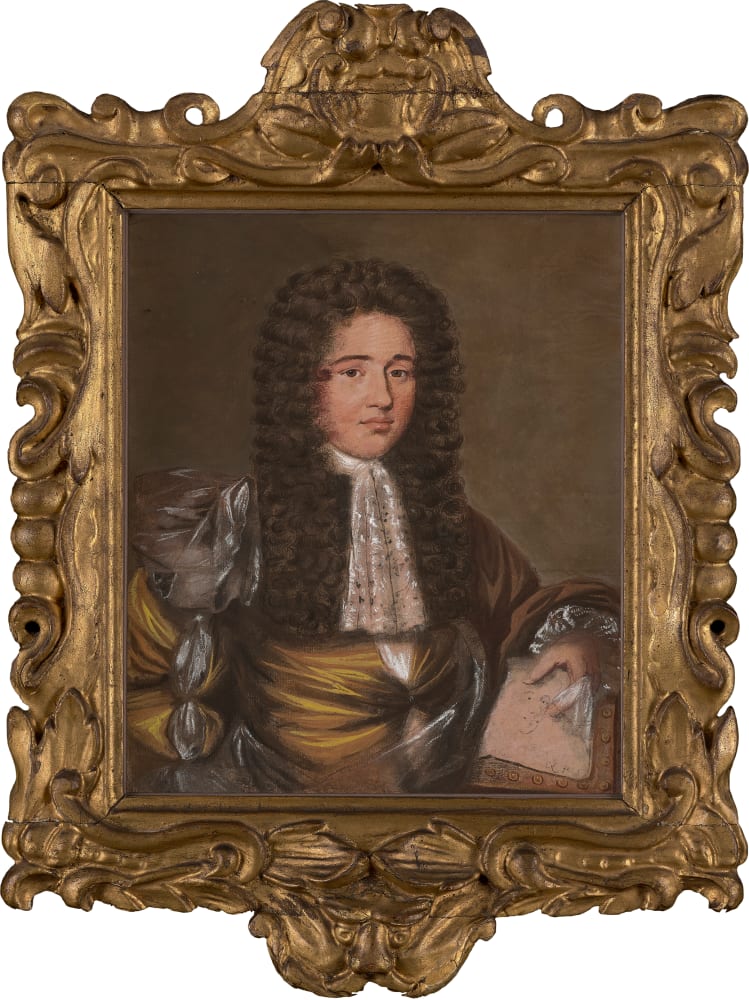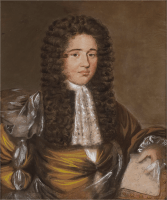


Edward Luttrell
(c.1650-1737) A Self-Portrait of the ArtistProvenance
W. A. Clare Lees of Ardeevin, Chapel-en-le-Frith, by 1964;
By descent until 2019.
Literature
Jeffares, N. ‘An Epitome of Painting’ (1683) by Edward Luttrell, The Walpole Society, Vol.82 (2020), p. 114 (illus.).
This is one of Luttrell’s earliest dated works. Only two others, one dating to 1674 and the other to 1677, precede this self-portrait.
In this work, the pastellist and engraver Edward Luttrell proudly shows the viewer a portrait on paper signed and dated by his own hand. It is a bold, confident likeness of himself captured during his formative years.
Edward Luttrell’s first choice of career was not as an artist. Instead, he had hoped in his youth to become a lawyer, studying at the New Inn.[1] At around this time, he also started to draw. He taught himself, according to George Vertue (1684-1756), so that soon what had begun as an out-of-hours hobby had become an obsession.
Luttrell soon dropped out of his studies at the New Inn to take lessons from the pastellist Edmund Ashfield (1640-1679).[2] Luttrell had a great admiration for his teacher, to whom he attributed many of the most significant innovations in pastels of the age. Writing in his unpublished 1683 treatise, An Epitome of Painting, Luttrell referred to him as an artist ‘whose memory will never...
In this work, the pastellist and engraver Edward Luttrell proudly shows the viewer a portrait on paper signed and dated by his own hand. It is a bold, confident likeness of himself captured during his formative years.
Edward Luttrell’s first choice of career was not as an artist. Instead, he had hoped in his youth to become a lawyer, studying at the New Inn.[1] At around this time, he also started to draw. He taught himself, according to George Vertue (1684-1756), so that soon what had begun as an out-of-hours hobby had become an obsession.
Luttrell soon dropped out of his studies at the New Inn to take lessons from the pastellist Edmund Ashfield (1640-1679).[2] Luttrell had a great admiration for his teacher, to whom he attributed many of the most significant innovations in pastels of the age. Writing in his unpublished 1683 treatise, An Epitome of Painting, Luttrell referred to him as an artist ‘whose memory will never dye’.[3]
Luttrell ensured that this was so. Just as Ashfield had innovated in his own day, greatly expanding the range of colours and materials used by pastellists, so Luttrell did the same. He developed Ashfield’s palette and tried his hand at techniques such as painting on glass.[4] Most notably, he devised a method for drawing with coloured chalks directly onto copper plates, which he “roughed” with a tool so that the pigments would hold. Luttrell was also skilled in the art of mezzotint, a form of printmaking that had recently been invented.
This is one of Luttrell’s earliest dated works. Only two others, one dating to 1674 and the other to 1677, precede this self-portrait.[5] As such, it represents an important moment in the formation of Luttrell’s professional identity and seemingly shows the moment at which, having learned his craft, he declared his readiness to begin his career in earnest. In this respect it provides an interesting counterpoint to the Epitome of Painting, written for his cousin Dorothy – the sister, incidentally, of the diarist Narcissus Luttrell – in 1683, three years after the execution of the present work. Providing a confident and opinionated survey of the techniques required of a pastellist of this date, the Epitome betokens the extensive experience that Luttrell had acquired throughout his training.
This self-portrait may have been executed in Oxford, where Luttrell took the likeness of the scholar John Barefoot in the following year – 1681. Barefoot was typical of the middle-class patrons from which Luttrell drew the majority of his commissions. Well-connected in the art world, John Evelyn, the diarist, recorded his delight on seeing Luttrell’s group portrait of his cousin’s children in pastels on copper, writing that it seemed to be ‘as finely painted as the best miniature’.[6] However, for reasons unknown, there is a dramatic decline in his output after 1705. In 1711, he was forced to sell 120 framed works by raffle, promising that some ticket-holders would receive fresh works executed by him from the life (they seem to have been disappointed, as only one work by Luttrell from after 1711 is known to exist).
[1] ‘Vertue Notebooks Volume III’, The Walpole Society, Vol. 22 (1933-34), p. 13.
[2] Buckeridge, B. ‘An Essay towards an English School of Painters’, in R. de Piles. (1754)The Art of Painting, with the Lives and Characters of above 300 of the most Eminent Painters… to which is added, An Essay towards an English School… London, p. 355; his dates taken from Jeffares, N. ‘Ashfield, Edmund’, in Jeffares, N. (2006) Dictionary of Pastellists before 1800, London: Unicorn Press. [online edn., http://www.pastellists.com/Articles/Ashfield.pdf, accessed 11th June 2019].
[3] Luttrell, E. ‘Epitome of painting, containing briefe directions for drawing, painting, limning and cryoons’, in Jeffares, Dictionary of Pastellists [online edn., http://www.pastellists.com/Misc/Treatises.pdf, accessed 11th June 2019].
[4] Egerton, J. (2004) ‘Luttrell, Edward (fl. 1680–1724)’, Oxford Dictionary of National Biography, Oxford, [online edn., 2010, https://www.oxforddnb.com/view/10.1093/ref:odnb/9780198614128.001.0001/odnb-9780198614128-e-17220?rskey=CI5CU9&result=1, accessed 11th June 2019.
[5] Jeffares, N. ‘Luttrell, Edward’, in Jeffares, Dictionary of Pastellists ) [online edn., http://www.pastellists.com/Articles/Lutterell.pdf, accessed 11th June 2019].
[6] Egerton, J. (2004) ‘Luttrell, Edward (fl. 1680–1724)’, Oxford Dictionary of National Biography, Oxford, [online edn., 2010, https://www.oxforddnb.com/view/10.1093/ref:odnb/9780198614128.001.0001/odnb-9780198614128-e-17220?rskey=CI5CU9&result=1, accessed 11th June 2019.



